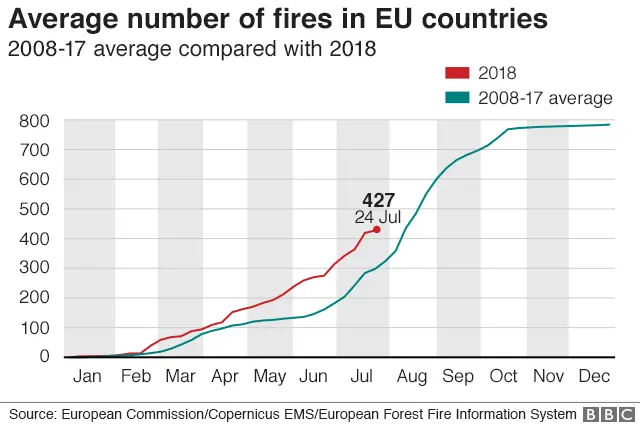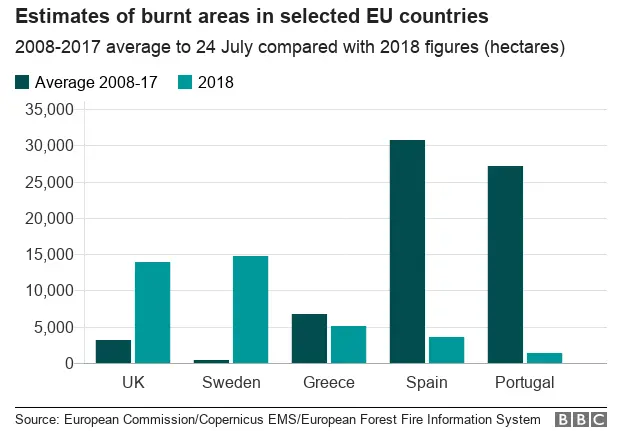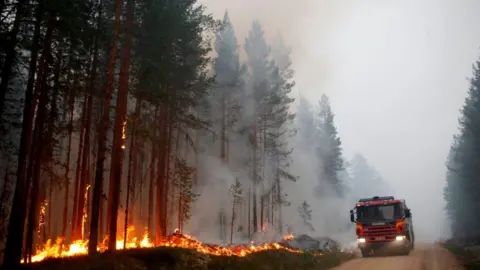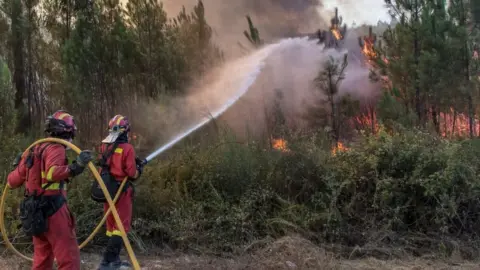Why wildfires are breaking out in the 'wrong' countries
 Getty Images
Getty ImagesAt least 80 people have been killed in wildfires in Greece, with blazes also reported as far apart as the US, Sweden, Canada and the UK. It's a summer that has seen an unusually high number of fires in some countries.
Worldwide, an area equivalent to about 20 times the size of Great Britain is burnt by wildfires in a typical year.
Most are in remote areas such as the savannah grasslands of Africa and South America, or the boreal forests which stretch from western Alaska to eastern Siberia.
But we rarely hear about wildfires in such isolated places. It tends to be those which threaten lives, infrastructure, or natural resources that hit the headlines.
Indeed, in Europe, the number of fires so far this year is well above average - but not in the countries which are usually worst affected.

There were 427 blazes between 1 January and 24 July, compared with an average of 298 for the same period in the past decade.
But, very importantly, the area they burned is only about half what is usually seen - 55,700 hectares, compared with 112,000 hectares.
In the US, the number of fires this year is slightly below average. However, there has been a small increase in the area burned, from just over 1.4m hectares to almost 1.6m hectares.
The most important change is not how many fires there have been, but where they are burning. The north-west of Europe is experiencing a rare heatwave.
This has brought unusually dry conditions which have allowed large fires in regions which usually see very few.

In the UK the area burned so far - 13,888 hectares - is more than four times the average of the past decade. The fires have included an area of peatland near Manchester and grassland in London.
In Sweden, the figure, 18,500 hectares, is an astounding 41 times the 10-year average. Dozens of fires have burned from the Arctic Circle down to the Baltic Sea.
Other northern European countries including Denmark, Estonia, Finland, Germany and Latvia have seen between 20 and 200 times the normal area burned.
In contrast, Mediterranean Europe - which usually sees a large number of fires - has had a relatively cool and wet spring and early summer.
In Italy and Croatia the area burned is well below average.
Spain and Portugal, which normally have fire damage over a greater area than any other European countries, have suffered relatively few fires - with only 12% and 5% of the average area burned, respectively.
However, fire season is not over and there is a danger that strong vegetation growth in parts of the Mediterranean may fuel fires later in the coming months.
 Getty Images
Getty ImagesWhile no single factor explains hot weather around the world, experts say climate change is bringing greater and more frequent weather extremes.
It is not that the 2018 fires in the UK and Sweden will be the "new normal", but they may be more common.
Higher temperatures worldwide increase the risk of wildfires in many regions, but other factors are also important.
To explain fire, scientists and firefighters use something called the "fire triangle": an ignition source, plus fuel such as dry vegetation and oxygen to keep going.
Wildland firefighters also use the "30-30-30 rule" under which extreme fire conditions are expected when temperatures are above 30C, relative humidity is below 30% and winds are greater than 30km per hour (18.6 mph).
 Getty Images
Getty ImagesDrought-stricken vegetation, such as the Swedish forests and the British moorlands, catches and carries fire more easily than it would in a wetter year.
In other words, there is more "fuel" available when the vegetation is dry.
Oxygen is readily available in the air - particularly when wind fans the fires.
And sources of ignition are plentiful where there are people, whether that is a campfire, a spark from a power line, or arson.
Natural ignition by lightning is common in some regions, such as the North America boreal forest, but in Europe the vast majority of fires are human-caused.
The deadly fires in Greece are a prime example of weather being only one important factor.
Until a few days ago, Greece had experienced fewer fires than is typical.
But, in a densely-populated region near Athens, the presence of villages and towns amid highly-flammable pine forests and shrubland has had tragic consequences.
Increase of "megafires"
 Getty Images
Getty ImagesSadly, such events have happened before.
More than 100 people were killed by wildfires in Portugal only last year and 173 people died in the Black Saturday Fires in Australia in 2009.
In recent decades, there has been an increase of "megafires".
These are too big and fierce to be stopped, irrespective of the efforts and resources thrown at them.


While climate change may have made more fuel available for such fires, human behaviour has also played a role.
In many rural areas of Europe land has been abandoned - leading to the growth of more vegetation close to and among homes. People often enjoy living or holidaying in forest areas, which also increases the risk of being directly affected by fire.
Fortunately, it is possible to reduce the risks this poses - by clearing "fuel" close to buildings and building fire shelters in areas where the population might need them.
Educating people about the risks and having evacuation plans in place can also reduce the threat to human lives and the economy.
We need to adapt and learn how to coexist with fire.
Fire has been transforming the Earth's landscapes and vegetation for millions of years.
It is not going to go away.

About this piece
This analysis piece was commissioned by the BBC from experts working for an outside organisation.
Prof Stefan H. Doerr is a geography professor at Swansea University and editor-in-chief of the International Journal of Wildland Fire.
Dr Cristina Santín is senior lecturer and research fellow in the biosciences department at Swansea University.

Edited by Duncan Walker
